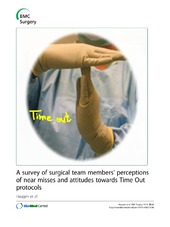| dc.description.abstract | Background: Medical errors are inherently of concern in modern health care. Although surgical errors as incorrect surgery (e.g., wrong patient, wrong site, or wrong procedure) are infrequent, they are devastating events to experience. To gain insight about incidents that could lead to incorrect surgery, we surveyed how surgical team members perceive near misses and their attitudes towards the use of Time Out protocols in the operating room. We hypothesised that perceptions of near-miss experiences and attitudes towards Time Out protocols vary widely among surgical team members. Methods: This cross-sectional study (N = 427) included surgeons, anaesthetists, nurse anaesthetists, and operating room nurses. The questionnaire consisted of 14 items, 11 of which had dichotomous responses (0 = no; 1 = yes) and 3 of which had responses on an ordinal scale (never = 0; sometimes = 1; often = 2; always = 3). Items reflected team members’ experience of near misses or mistakes; their strategies for verifying the correct patient, site, and procedure; questions about whether they believed that these mistakes could be avoided using the Time Out protocol; and how they would accept the implementation of the protocol in the operating room. Results: In the operating room, 38% of respondents had experienced uncertainty of patient identity, 81% had experienced uncertainty of the surgical site or side, and 60% had prepared for the wrong procedure. Sixty-three per cent agreed that verifying the correct patient, site, and procedure should be a team responsibility. Thus, only nurse anaesthetists routinely performed identity checks prior to surgery (P ≤ 0.001). Of the surgical team members, 91% supported implementation of a Time Out protocol in their operating rooms. Conclusion: The majority of our surgical personnel experienced near misses with regard to correct patient identity, surgical site, or procedure. Routines for ensuring the correct patient, site, and surgical procedure must involve all surgical team members. We find that the near-miss experiences are a wake-up call for systematic risk reducing efforts and the use of checklists in surgery. | en_US |

